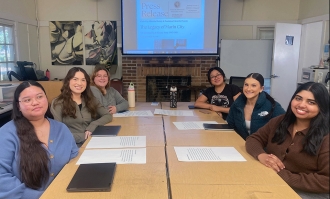- News
- News Archive
- Students Share Reflections Of COVID-19 In Arts Course
Students Share Reflections Of COVID-19 In Arts Course

With the fall semester starting online until state health officials approve a campus reopening, Lynn Sondag, associate professor in the Department of Art, Design, and Visual Studies, is presenting final reflections from an online class she created at the start of the pandemic for students to express their stress and anxiety about the COVID-19 crisis through art.
The course reflection journal assignments were revised in March during the initial coronavirus outbreak. After the students were unable to continue their service-learning partnership with Kids Club, Sondag sought to seek insight from her students through art projects. The theme of the Art Fundamentals distance-learning class shifted to being based on the eight studio habits of mind, what the arts teach, and who has access to the arts education.
“Students seemed overall happy to reflect on the connection between art and creativity and well-being during the shelter-in-place order,” Sondag says of their final reflections.
Here is Sondag’s essay summary of the class and excerpts from students’ personal final presentations:
Change and disruption shine a light on ideas and situations often over looked or undervalued. It was refreshing to learn that the students valued creativity as a way to calm their nervous systems and garner belief in self-efficacy. The projects also helped them practice mindfulness and relaxation. When creating the assignments I kept in mind the college student’s home experience and what would enable them to be success and engaged.
For the final reflection the students were given a choice to reflect on the arts education/educational justice theme of the course, or the arts and wellbeing during COVID-19. One of the last drawing assignments was to create a graphic narrative about their “place,” noticing small details and larger settings. Many of the students spoke about how helpful the art projects were at this time, and almost all are pursuing a degree medicine, healthcare, or education. It was an opportunity for them to take a unique situation to a personal and professional level. The vast majority chose to the “arts and well-being” prompt.
This prompt introduced students to research connecting the arts and well-being, which has been ongoing well before the COVID-19 global pandemic. Through a partnership with Artplace America, the University of Florida Center for Arts in Medicine has created a COVID-19 Arts Response (https://arts.ufl.edu/sites/creating-healthy-communities/covid-19-arts-response/call-for-collaboration/), which provides resources “for using arts to advance and support communication, connection, coping and wellbeing in the COVID-19 crisis.” Students found the Infographic Mobilizing the Arts for COVID-19 Communication and Coping particularly impactful. It outlines ways we turn to the arts in challenging times and most students related to the findings.
REQUEST INFORMATION ABOUT DOMINICAN'S UNDERGRADUATE PROGRAMS
A majority of the students spoke about how their art assignments helped them cope with the global pandemic situation and provided stress relief while working from home. They could explore creatively, experience joy, and connect with something deeper. It was interesting to hear from several students that working outside in their yards and away from a computer made a big difference:
“Creating art within the past couple of months has given me the time to be joyful and enjoy the outdoors. After completing my art assignments and the individual pieces I’ve done for fun, I feel refreshed and able to go back to complete other work.”
“I started the assignment in my backyard and working with the watercolor overcame my body with a wave of peace and serenity. Every part of this assignment was quite enjoyable for me.”
“I’ve been doing all of the art assignments outside, taking the opportunity to get fresh air and enjoy the beautiful outdoors.”
“I’ve needed breaks and art has been one of the activities I participated in that helped me relax and take a step back from the constant conversations focusing on COVID-19 and the challenges of staying home.”
Another outcome was that several students spoke to how making art at home inspired them to seek out creative projects in their living spaces. This mindset increased their artistic and creative confidence. In this class students are introduced to the Eight Studio Habits of Mind, which are thinking dispositions that the arts teach, such as: Observe, Express, Envision, Imagine, Stretch and Explore, Engage and Persist, Develop Craft, and Understanding the art world. While these modes of thinking are cultivated through art making, students found their transferability to other areas of their lives:
“Through art, I was able to redirect all of my thoughts into creating and expanding my own abilities as an artist. I was given the tools to envision my life in a new way, inspiring me to start redecorating my room, and really developing my own safe space here, as I did back at school. I would find myself in the zone for hours, just painting or writing, truly just relishing in the moment. Exploring different mediums and figuring out what works the best for me has given me a chance to expand my horizons and focus on the brighter side of this situation.”
“Being home as a family for such an extended period time has given us all some much needed time as a family who has the tendency to be constantly moving. And while my school work took a back burner out of sheer necessity, my kids and I found many ways to be creative together that brought all of us joy in a sense of ritual. These new additions to my schedule allowed me to “stretch and explore,” because if there is one thing a three year old does really well artistically, it is starting something with no preconceived plan about where it’s going to end. It’s also been refreshing to be able to “express” myself creatively with the kids….."
Lastly, another theme that emerged from the students writing is that they discovered their artistic potential and the mental health benefits that arts bring, which will benefit them in their personal and professional paths:
“My art assignments have been study breaks or late night projects that I enjoy working on. Since the switch to online art, I have had more time to create more of my own art. I have also rediscovered my love for art. So much, in fact, that family and friends started buying me art supplies for my birthday as I continued to show them my art.”
“I am studying to become an Occupational Therapist and the importance of mental health on top of physical health is very important when caring for patients. I learned that in order to properly care for a patient, you must first care for yourself. Focusing on my art assignments, and organizing what I needed to get done set me up for success during this difficult time.”
“Creating art from real things in my life has made me appreciate them so much more, and has taken my mind off of the anxiety that can be felt by staying in one place for so long by reminding me of all the beautiful things I am surrounded by on a daily basis.”
“I’ve had time during this pandemic to touch upon my artistic side, it was nice to see what art can do for one’s mental health or form of expression. The arts are something that people should pay more attention to and deem as an important and necessary part of children’s education.”
While there were benefits to providing a final reflection option where the college students could speak to their own experience, it was difficult to step aside from the community partnership involvement. At the beginning of the semester were weekly art activities with the youth at Kids Club, which were an integral part of the assignments, written reflection prompts in particular. These early reflections drew on the connections made through this experience – casual dialog and art making, which led to relationship building. Personal relationship building is central to this course. Assigned readings provide a background to systemic issues that lead to educational inequity and the arts role in addressing some of these issues. They also learned about local schools and youth in underserved communities in Marin County --and some of the college students can speak to this first hand. Dominican students were disappointed that the partnership couldn’t continue. Reaching out to Kids Club Director Lauren Muszynski, we arranged for the college students to write a letter to their youth partner appreciating their time together and getting to know them.
Drawings by Chrystal Kaye Cortez
The Dominican Experience
Experience Connectedness
Experience Accomplishment
The Dominican Experience allows you to work with a coach, complete a signature work, build a digital portfolio and engage with the community. What will your experience look like?



